Classic French Boule
This classic French boule is incredibly easy to make and produces a delicious, crusty artisan style loaf of bread without any of the fuss.
Over the past year, yeast, an ingredient that once intimidated me, has quickly become one of my favorite ingredients to use in the kitchen.
I’ve experimented with multigrain loaves, no knead focaccia, and dinner rolls, but this French Boule is one of my all-time favorite easy bread recipes.
The dough is incredibly easy to make and the resulting artisan-style bread has a lovely hearty crusty and crumb. This bread pairs wonderfully with homemade soup. It can also be used for sandwiches or sliced and served plain with salted butter. In my opinion, great bread doesn’t need a lot of frills or toppings.
If you love this bread and are looking to take your bread baking skills up a notch, I highly recommend trying your hand at homemade sourdough next.
This French Boule dough, which yields two 2-pound loaves, can be stored in the refrigerator for up to two weeks, allowing you to make homemade bread any day of the week. I promise, after tasting this bread, you’ll be making it all the time.
The recipe is adapted slightly from one of my favorite cookbooks, Artisan Bread in 5 Minutes A Day, by Jeff Hertzberg and Zoë Francois.
The original recipe calls for 100% unbleached white flour. This version contains a mixture of whole wheat flour and the end result is even more delicious, while still retaining a crusty exterior and not being overly dense. Happy bread baking!
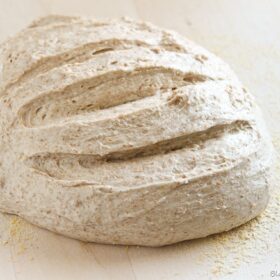
Classic French Boule
Ingredients
- 3 cups (680g) warm water (95°F/35°C)
- 1 tablespoon + 1½ teaspoons active dry yeast
- 1 tablespoon + 1½ teaspoons (18g) kosher salt
- 4 cups (560g) unbleached all-purpose flour
- 2½ cups (350g) whole wheat flour
- semolina or cornmeal for dusting
Instructions
- The Day Before Baking: In a large container(with non-airtight lid), whisk together warm water, yeast, and salt. Slowly add in all-purpose and whole wheat flour, mixing with wooden spoon. When dough becomes too difficult and thick to stir, start mixing with your hands until all the flour is incorporated and the dough is uniform in texture. It should be very wet and sticky, do not knead the dough. Cover the dough lightly (do not seal container) and allow to rise at room temperature for at least 2 hours. Transfer dough container to the refrigerator. Dough can be used the following day or stored for up to 2 weeks.
- Important Baking Note: Steam enables the bread to develop a crusty, crisp exterior. One way to incorporate steam into your oven at home is to place a broiler tray on an oven rack and fill it with very hot water immediately after placing the loaf in the oven. Close the oven door immediately. If you do not own a baking stone or steel, you can also bake this loaf in a Dutch oven using the method outlined in my artisan sourdough bread recipe. It will yield even better results.
- Before Baking: Preheat a pizza stone or steel to 450°F (230°C) for at least 45 minutes. Dust a pizza peel lightly with semolina or cornmeal, remove half of the dough from the refrigerator and quickly “cloak” and shape the dough into a tight round. This shaping process should only take about 30 to 60 seconds total. To do so, stretch the surface around to the bottom of the loaf, creating surface tension on the top of the loaf so that the surface is relatively smooth. Allow the shaped boule to rest uncovered at room temperature for 45 minutes. Equipment Note: If you do own have a pizza peel, place dough on a half sheet pan lined with parchment paper.
- Once the oven has preheated, lightly dust the top of the loaf with all purpose flour and using a serrated knife, score the top of the loaf with a scallop pattern (see photo) or # pattern. The individual scores should be no more than ½-inch deep.
- Transfer the dough onto the pizza stone (or place the baking sheet in the bottom third of your oven) and bake for 35 to 50 minutes, or until the internal temperature reads between 190°F-200°F (88°C-93°C). Allow loaf to cool on a rack for 1-2 hours before slicing. You can slice into the bread earlier, but allowing it to cool completely yields a better crumb texture and helps prevent the bread from losing moisture and staling faster.

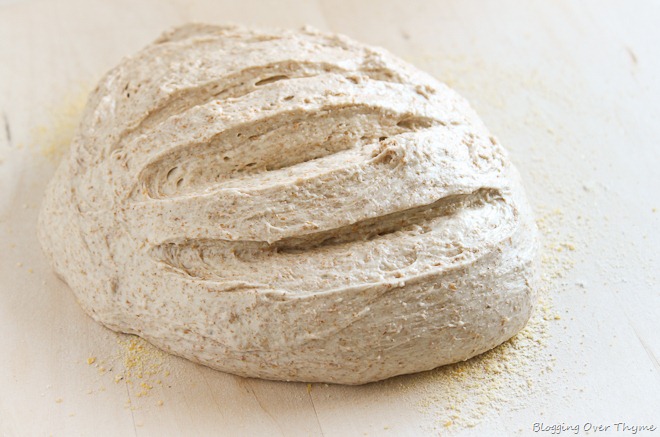
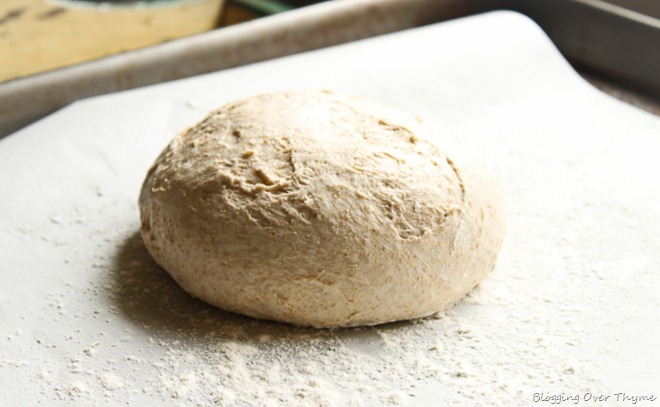
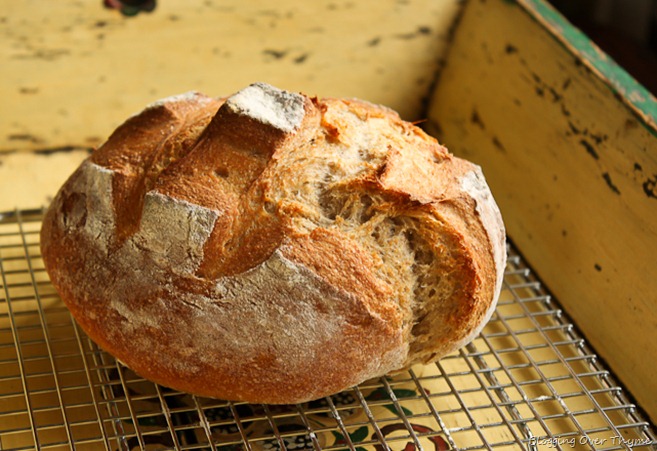
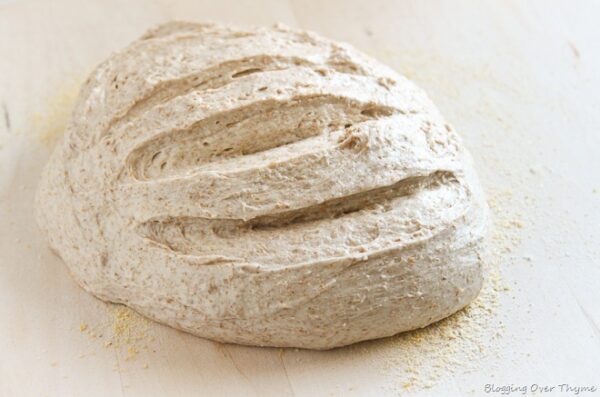
77 Comments on “Classic French Boule”
Hi there!
I saw how it was as I was making it so just adjusted it to a more likely dough hydration percentage by adding more flour. Just thought I’d point it out 🙂
Thanks for the reply 🙂
N
Appreciate you pointing it out to me and being understanding!
Hi. Are you sure about the metric measurements for the flour as that dough is nearly 100% hydration. It’s like porridge…
Hi Nico – sorry, there was a big error in the gram conversions (that were added later – I use a different conversion for cups than the original recipe that this was adapted from). This recipe/post is over 12 years old and is not one that many people stumble upon my site and therefore hasn’t been updated since it was originally published. I have just updated the gram measurements and will plan on updating this soon per my current standards. If you made the dough and need help, you could bake it like focaccia, that’s probably the best option at this point.
I love this recipe! I have tried it several times. The first couple times, it seemed a touch on the salty side, so I reduced the salt to 1 Tbsp. It was perfect. I bake it at 450° for about 45 mins until internal temp is 190°… Pan of water in the bottom of the oven on an open cast iron skillet. I’ve baked it with no cover (top was too brown) then lightly covered with foil ( it was perfect). Thank you for sharing this great recipe! The 2 loaves last our family of 3 about a week (we eat lots of bread).
I need to update this recipe to include metric weights, but every brand of salt varies significantly in density, so that could be the culprit. Use Diamond Crystal brand when in doubt!
Can I substitute beer for part of the water?
Hi Keith,
I personally haven’t done this before and this isn’t a traditional beer bread by any means, but I don’t see why not…I just can’t personally advise how it will impact the dough. Sorry!
Laura,
can I bake this bread in a cast iron dutch oven like sourdough?
Yes! That would work well! I haven’t personally done it, so can’t quite give exact tips (this recipe is one of the older ones on my site and I haven’t made it a while), but a lot of doughs can benefit from that type of baking method. If you’re looking for a sourdough recipe, this is my go-to and a popular one on my site: https://www.abeautifulplate.com/artisan-sourdough-bread-recipe/
Do you think I could let this rise for 45 min. in an unlined proofing basket (I love the spiral lines it creates on the crust) and then invert into a pre-heated pizza stone?
Hi Lisa,
I haven’t tried that with this recipe (I’ve done this with sourdough), so unfortunately I can’t say for sure, but I don’t see why not. Hope this helps!
Hi Lisa,
I proof mine in a basket, then turn it out onto parchment paper, and place it on the hot stone. Comes out beautifully!
Snap! I forgot to say that I used a rimmed baking pan with water in it at the base of the oven to create a steam bath which made the crust divine.
Fantastic Recipe!
EASY AND FUN! Followed it step by step- EXCEPT!! – on step 4. I didn’t dust it with floor…. as instructed. I used flour instead. Thanks for my FIRST EVER BAKED BREAD!! YAY! Thank you a million times <3
xoxo
I just tried this recipe but it was too wet so I struggled to shape it, let alone slash it with a knife (it was self healing). Even so it cooked nicely and tasted good, although was definitely too salty. I think I may have interpreted the flour measurements incorrectly, using a total of 780g flour… I’m hoping if I increase the flour content next time, it’ll solve both the wetness and saltiness problems.
Warning! Novice, pandemic-inspired baker speaking! I attempted to follow instructions exactly, but my dough fell a little in the fridge. The dough was in the fridge for about 24 hrs. I went ahead and baked it. It had a good flavor, but was obviously more dense than a boule should be. Any pointers here? I’m wondering if it was because I only covered it with a towel? It did form a crust while in the fridge. Thanks for your help! French Boule is one of my families favorite bakery items!
If the dough fell a bit in the fridge it sounds like it might have over-proofed – or dried out a bit. I would recommend covering it tightly with plastic wrap or even a plastic shower cap (the ones that hotels give out, they work great and you can reuse them!). If it develops a crust, it will definitely lead to issues during baking.
Hi. I made this today and it came out horribly. It barely rose yesterday and didn’t change upon overnight refrigeration. It rested for an hour and spread to double its size. The loaf is basically wide and flat, no rise at all. Yeast is new, flour was new unopened bag, but did sub pink salt for kosher because it’s what we have. Thoughts? Like another commenter above I am in New Orleans and it’s very humid here.
It sounds like perhaps the salt substitute created a lot of problems. You mentioned new yeast, but it also sounds a bit strange that it wouldn’t do anything. Pink salt (depending on the grind) is a lot more dense than kosher salt, so it sounds like you might have unintentionally added a LOT of salt, which can have massive effects on fermentation and yeast activity. There is also a possibility it’s too warm, or that you might have to compensate for the humidity a bit? Or it over proofed somewhere along the way? I’m really sorry I can’t be more helpful, that’s the first feedback of that that kind that I’ve received on this recipe, and it’s so hard to know the variables that go into it.
I made this bread tonight and my family absolutely loved it. Was the perfect accompaniment with a beef and barley stew on this cold snowy night!
So happy to hear that! Thank you for taking the time to leave your review!
You should never put salt in active yeast. It kills the yeast. Better to proof the yeast for ten minutes in a warm spot with sugar (as required on the yeast label). Once it’s frothy and happy, you can add the flour and salt as you go.
Hi Laura! This is actually a misconception – salt does not kill yeast (unless in very large concentrations). Salt just inhibits yeast’s activity and slows down fermentation. For this recipe, I can assure you, you will not kill the yeast by mixing all of the ingredients together at once. I hope you have the chance to try it, because it is a very easy fool-proof recipe and technique!
Also, another quick note: modern yeast does not need to be activated or proofed before mixing with other ingredients. Unless your yeast is far past the ‘expiration’ date or you’re afraid it is not longer active, this is an unnecessary step. Hope this helps!
Thank you! I’ve been enjoying making this recipe for the past few weeks. I don’t put the salt into the wet mix with the yeast, but I do mix it into the flour, and it works quite well!
I’ve tried cooking it after the rise (gave it 3 hours) versus out of the fridge, and you’re right – it’s actually much better if it sits overnight.
It’s also easier to work with if you use some oil spray on the rising bowl.
Hi, I subscribed today. Your vlog is great! Can you explain what a “cloak” is on the bread? I have tried to find this but no descriptions relate to the word “cloak”.
This recipe has come out really nicely twice – once with active dry yeast and once with instant. I mix the salt into the flour because I’ve heard direct contact between yeast and salt can inhibit the yeast… although your results make it seem like that isn’t a big deal. The instant yeast did seem to negate a tiny bit of the yeasty flavor, which I preferred, but the loaves weren’t distinguishably different in appearance or texture. There was a pizza peel stickage issue once (oops – wider cornmeal/flour spread necessary), but nothing catastrophic. It’s really so incredibly easy, without preservatives, delicious, and a fraction of the $4-6/loaf found at the store. Fresh out of the oven, it’s got a divine crackled crust that continues making the most joyful noises as it cools. I’m currently resting another batch on the counter!
The questions, though: have you been successful in mixing in garlic, olives, etc., or would those elements sink in the dough? And have you used bread flour to any noticeable effect?
Hello Laura. As with millions of others, I’m going to try making bread during our Covid lockdown here in South Africa. I hope this isn’t a really dumb question, but I don’t own a wooden spoon! Is it ok to use a metal one…or a stand mixer + dough hook? I’m asking about the metal vs wooden spoon, as I know metal can sometimes react with ingredients.
Yes! Metal is fine!!! Or your hands ?
Thank you Laura! ❤️
I made a loaf of this bread today and it turned out OK. I followed the recipe to the letter (I think) and the bread is way too dense; no holes in the bread and it’s heavy.
I’m guessing I did something wrong but not certain what that might be. I’ll appreciate any suggestions you may have to suggest how to make it lighter (less dense).
This isn’t a naturally fermented bread, so the holes won’t be very large – but it definitely shouldn’t be very dense either. It sounds like perhaps your yeast might be dead? Did it rise properly? Perhaps you measured your flour too generously? There are a ton of possible factors that could be to blame! I wish I could help!
I have made hundreds of loaves of bread, in all different climates. This is one of my favorite things to do. It’s always amazing how a recipe description doesn’t quite match what you experience with your hands, but bread does work, and even when it’s not perfect it is still delicious and worth the practice.
The best breads I’ve made have often been almost by accident.
I took a class at Le Pain Quotedienne, and that was using weight instead of volume, with presumably very good ingredients, and it taught me a lot about what to expect when your oven isn’t quite right, or you don’t have a humidifier, or if your yeast is a little dead, or if you over-knead, and how to shape it, or frankly if you’re just in a rush and you don’t let the dough work.
Dough is not to be manhandled, it is a fiber structure that you want to grow, not break. Hard to explain.
These are just thoughts, I am no expert, but just wanted to share things I have found. It was really helpful to make many many loaves and then take a class and then make many many more.
Love it!
Pingback: French Boule – Pumpkin Pie and Me
I don’t know what you mean by this Stretch the surface of the dough “cloak” and shape loaf in a round in about 30-60 seconds—stretch the surface of the dough ball around to the bottom of the loaf, rotating the dough ball as you go. I looked at a video but all I could find was about stretching pizza dough. Thank you
Shreya,
Your problem may be in how you measured your flour. If you scoop it from its container it compact it and can result in up to 20% more flour. Instead loosen the flour using a spoon, prior to measuring it. Then, using dry measuring cups (you know, the individual cups….1/4 cup, 1/2 cup, etc.), use the spoon to scoop flour into them. Then using the side of the spoon, level it off.
Do I really have to store the dough in the fridge for 2 weeks before kneading and bake?
Hi Sieg! You definitely do not need to store the dough in the fridge for long before kneading and baking. I just personally recommend letting it sit in the fridge for a few hours or overnight, so that it is easier to handle and doesn’t spread quite as much prior to sticking in the oven. Hope this helps!
I love this recipe and have had great success with it. Thank you! I only had white flour on hand and accidentally nearly doubled the yeast but it all worked out great.
Yay! I’m so glad it has worked so well for you. I’ve had similar experiences, and have come to find that this recipe is really forgiving, which I love! Thanks for the feedback Amanda!
Hello!
We are having a snow day here in NY and, after making a day-long Punjabi feast yesterday, decided it was bread day today. Kris made the dough before starting calculus homework and the kids and I watched him pick all the wet bits off his fingers 😉
Just checked the dough (which I put near the door instead of in the fridge – it’s really cold today!) and it’s risen to double in 2 hours!
REALLY excited to get this in the oven. Will let you know how it turned out.
Jess
Pingback: No-knead Bread | I Smell Like Butter
I made the first batch with partial whole wheat flour, as above. I loved it but my young grandson pointed out that it “was more like sandwich bread” than what he saw at the bakery. Today I’m trying it with all white flour and will keep the dough in the fridge for a day or two to see how the results differ.
Have this bread in the works right now – and will be ready for the oven shortly. The recipe is so easy! – looked it up after seeing French Boule in a local bakery. Very excited to see how it turned out – is a gift for my grandsons tomorrow. They luuuuuv homemade bread!
Oh my gosh, I am so happy to hear that! Please, please leave a comment letting me know your thoughts once you have tasted it. It is still one of my favorite bread recipes ever.
Hi Laura,
Just thought I’d let you know that the dressing was the best I ever had! Thanks for the great recipe!
Wow! So glad to hear it! Thanks so much Tom!
So, I just took the bread out of the oven and decided that I need to make the other loaf right away because it looks so good I might eat it all before I have a chance to make the dressing! It did rise a lot in the oven. I’ll still try the other loaf at 15 minutes instead of 45. Thanks for you help!
Yay!! 🙂 So glad you liked it.
Wow! Thanks for the quick response! I made the dough last night and just took it out of the fridge. Boy, did it expand a lot. It’s on the baking sheet ready to go in the oven. It looks a lot flatter than the one in the beautiful picture. Did I do something wrong? By the way, I’m in South Florida. Is humidity a factor? I’m going to use the bread to make homemade dressing for tomorrow.
Of course! Did you shape the dough with your hands before putting it in the oven? If you live somewhere where its hot (or your kitchen is very hot), it will definitely be a little flatter (if thats the case, and you prefer a taller loaf, try just allowing it to rest at room temperature for 15 minutes, as opposed to 45), but it should rise quite a bit during baking. It will still be delicious regardless though! And if you’re using it for dressing, the looks don’t matter quite as much 😉 Please let me know how it turns out!
Do you punch the dough down at all?
Can you bake it after the rest period or does it have to be refrigerated first?
Hi Tom! Thanks for your question–you don’t need to punch down the dough. Although you can use the dough immediately after allowing it to rest for two hours–I recommend refrigerating it for at least an hour or two (or overnight, if you have the time), so that it is a little bit more firm and easy to work with. It will result in a higher loaf, because it won’t be quite as loose going into the oven. But you CAN bake it after the rest period. Please let me know if you have any more questions! Thanks!
Whitney — Thank you for asking this question! This bread dough is definitely wet–it is actually a good thing, but it makes it difficult to work with when at room temperature. You might already be doing this, but definitely do the resting in the fridge after initially making the dough, as that will help a lot.
As for the spread during resting to come to room temperature, I suggest experimenting (although I can't say I have personally done this) and maybe decreasing the rest time by half and then trying to bake. Hopefully that will eliminate some of the spreading with time! See if this works, and definitely get back to me and let me know the results. Thanks for visiting!
Laura:
I live in the ever-humid area of New Orleans and have been having a problem with the dough. It is exceedingly wet, and spreads over a massive area when I let it rest for 45 minutes. What would you suggest I adjust to remedy this problem? I have been adding more flour, but it results in a very dense and dry bread.
Thanks!!
Tom LIm — I'm glad you asked this, because its actually something I was curious about ever since you brought it up. I looked to the original recipe inspiration source and they say that instant yeast (and actually any type of yeast) should work just as well with this recipe.
However, the storage time of the dough in the fridge really enables this to be possible without any major changes, so don't skip that part! Hope this helps!
Can I substitute Active Dry Yeast with Instant Yeast for this recipe? What would therefore change? Eg. rise time, amount of yeast, amount of water, flour, etc. Thanks in advance.
Zenedidyk — I learned from somewhere that the best way to store bread is leave it cut side down on a cutting board. Occasionally, if it has been more than a day or two, the crust starts to get too hard this way, but I feel like it eliminates the moisture problem from putting it in ziploc bags. Another option is to stick it in a hot oven for 10-15 minutes to get the crust crispy again! That always makes a big difference. Hope this helps!
Sheebee — Hmmm…I haven't done this with this recipe. I'm not sure if it would work as well–and it might lead to a drier bread. I would say just do the same technique and see how it works out. Can't promise anything though! But be sure to let me know how it goes if you do 🙂
I want to make rolls instead, Do you think the recipe would adapt well to that? Any suggestions? Thanks!
Hello, beautiful photos! I recently learned to make this kind of bread and I'm loving it. Do you have any suggestions for how to store the bread once it's baked (like to eat the next day after baking)?
No seriously–you can store the dough for up to to TWO weeks! Pretty incredible, huh?
It actually develops a slight sourdough taste as well. Enjoy! 🙂
My heart just dropped. “Place in refrigerator and cover lightly for up to two weeks.” ??? Say it ain’t so. Hahaaa, I’m sure it’s a typo coz I mean, that would just be abuse.
that looks straight out of a bakery! amazing. will definitely have to try this but i can absolutely guarantee it will not compare to yours 🙂
It really isn’t! I don’t know why it took me so long to get around to using it more frequently. I always used to worry about proofing it or mixing it with the right temp water—but this bread recipe is not picky about any of that stuff. And it turns out better than most complicated bread recipes!
Thanks so much Joanne! Love your blog, by the way.
Thanks so much Nuria! I love making bread, something about it is so comforting. And nothing beats the fresh stuff! 🙂
Definitely let me know if you try it, you won’t be disappointed!
Laura
I used to be deathly afraid of working with yeast but once you do it a few times, you realize it’s not such a big deal! Though the bread you get out of it IS kind of a big deal….and a delicious deal. This looks amazing. Straight out of a bakery window.
You’ve got a beautiful blog, Laura! I have tried to make my own bread too and I know it’s a wonderful experience! Would love to try your classic French Boule 😀
Thanks so much Lindsay! That means a lot 🙂
Do I have to let the yeast sit for a couple minutes before mixing everything together, or do I just mix all the ingredients immediately after putting the yeast in the warm water?
You can just mix the ingredients in! Thanks for the great question.
Yes! It’s the exact same one.
Is this the recipe that you made for us?!?! Thanks for posting the recipe!
Wow – I’m totally distracted by your pictures! Love them!
Hi,
I am trying to make this bread , while kneading my dough was not sticky and was on the dry side.i followed the recipe exactly, should i have added more water(more than 3 cups).
Hmm…the dough definitely shouldn’t be dry–it should be very wet, actually. Are you sure you incorporated all of the water or used the right flour measurements???
HI Laura,
Actually my dough after keeping for few hours was in good shape.Although it was very hard to mix it, but the end result is great.I had a perfect bread